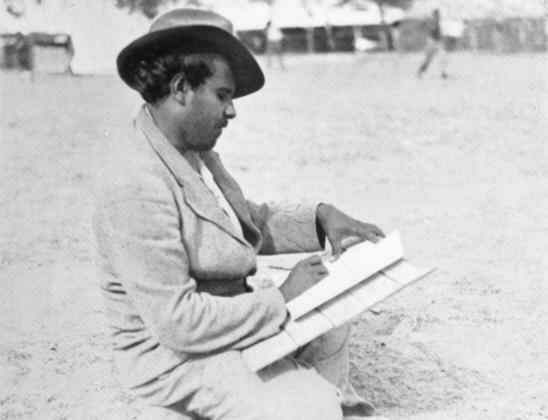WALTER EBATARINJA
BIOGRAPHY

Walter Ebatarinja was among the amazed and delighted local Aboriginal audience who attended the initial exhibition of watercolours by Rex Batterbee and John Gardner at the Lutheran mission in Hermannsburg in 1932. Walter, already an accomplished craftsman, wished also to be taught the new painting method like his uncle Albert Namatjira. He had to wait however until Albert returned from his painting trips with the visiting artists, and then press him into imparting his new skills. Albert taught his sons to paint and a few of his wider relations, including Walter, often including them in his trips into the McDonnell Ranges and the dramatic gorges along the Finke River. In turn, Walter taught his wife Cordelia to paint, and then his sons Joshua and Desmond. This is how the Hermannsburg School of watercolourists began.
Despite Namatjira’s popularity, much criticism was levelled at the Arrernte artists because of their adoption of European materials and the introduced Realist style, so foreign to the acceptable Aboriginal cultural experssion at the time. Critics called it a ‘popular craze’ or ‘pretty pictures’ of imitative value only, rather than of artistic merit. Yet their consistent sales proved a strong incentive and public appreciation carried the day. Their luminous watercolours found their way into the hearts and minds of the Australian imagination and finally the art establishment. Contrary to initial perceptions, this new translation of the landscape was actually in keeping with the traditional, spiritual relationship between the artists and their country. The paintings have genuine meaning, tracing as they do the much loved landforms, full of ancient stories and hidden sacred sites, not unlike the forms of other Aboriginal art that depict country from a taditional omnipotent perspective. The paintings are more than landscapes in the conventional sense of scenery. They arise as part of the land and reflect an attentive custodial sensibility towards it. Arrernte landscape painters are part of a continuing tradition that today is becoming more important than ever.
Walter’s son Desmond Ebatarinja recalls his parents’ artistic activities, which brought much needed money into the family during difficult drought years. The children were sent away to the mission school while Walter and Cordelia lived at the Palm Valley camp, twelve miles out of Hermannsburg and sold art to passing tourists. In those days, the paintings had to be stamped by the Native Affairs Branch to be 'approved' by the authorities and attract good prices. Desmond remembers coming home during holidays and swimming in the Finke River and watching his father paint. Walter developed his own recognisable painterly style, often using clusters of dots and areas of parallel lines as he analysed the land in more broad and geometric terms. Cordelia meanwhile gave more attention to a decorative quality. “When we’re painting country we think about the Dreaming of that country,” Desmond said. “My parents taught me to paint like that.” Arrernte country was centred around Alice Springs and, though the traditional owners were pushed to its outer missions and margins, today’s thriving art centres still rest on the enthusiasm, skill and international reputation of the foundational Hermannsburg painters.
Profile author: Sophie Pierce
Edited: Adrian Newstead
Collections:
Artbank, Sydney. Art Gallery of South Australia, Adelaide.
Flinders University Art Museum, Adelaide.
Museum of Victoria, Melbourne.
National Gallery of Australia, Canberra.
National Gallery of Victoria, Melbourne.
Parliament House Art Collection, Canberra.
Queensland Art Gallery, Brisbane.
The Kelton Foundation, Santa Monica, U.S.A.
Exhibitions:
1963, The Melbourne Moomba Festival, Exhibition of Aboriginal Art, presented by the Aborigines Advancement League, in conjunction with the Myer Emporium, Melbourne, Victoria.;
1991, The Heritage of Namatjira at Flinders, Flinders University Art Museum, Bedford Park, South Australia.;
1992/93, The Heritage of Namatjira, touring exhibition, through Flinders University Art Museum.; 1995, Namatjira Ilakakeye, kinship, creativity and the continuing traditions of the Hermannsburg artists, Tandanya, Adelaide.
References
Battarbee, R., 1951, Modern Australian Aboriginal Art, Angus and Robertson, Sydney. (C) ; Battarbee, R. and Battarbee, B., 1971, Modern Aboriginal Paintings, Rigby, Adelaide. (C)
Berndt, R. M. and Berndt, C. H. with Stanton, J., 1982, Aboriginal Australian Art, a Visual Perspective, Methuen Australia Pty Ltd, Sydney.
Hardy, J., Megaw, J.V.S. and Megaw, M.R. (eds), 1992, The Heritage of Namatjira - the Watercolourists of Central Australia, William Heinemann, Australia. (C)

